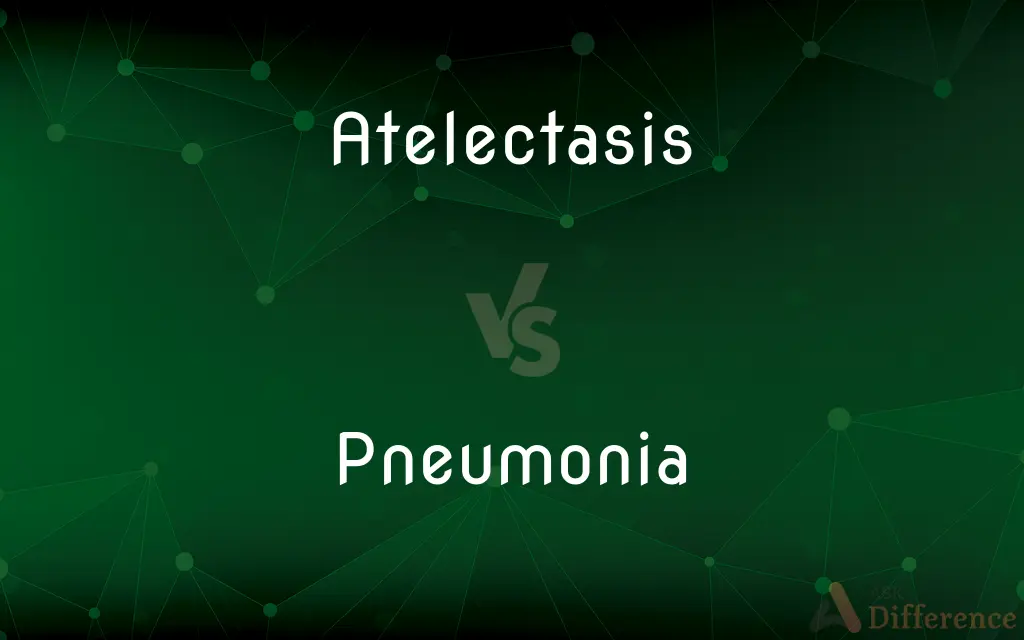Atelectasis vs. Pneumonia — What's the Difference?
By Tayyaba Rehman — Updated on September 28, 2023
Atelectasis refers to the partial or complete collapse of a lung segment or lobe. Pneumonia is an inflammatory condition of the lungs caused by infection. Both conditions can reduce lung function but differ in causes and presentation.

Difference Between Atelectasis and Pneumonia
Table of Contents
ADVERTISEMENT
Key Differences
Atelectasis and pneumonia are both pulmonary conditions, but they differ significantly in their origins and implications. Atelectasis is characterized by the collapse of a segment or an entire lobe of the lungs, leading to reduced or absent air in the affected area.
The causes of atelectasis can vary. It may result from a blockage in the air passages or from external pressure on the lung tissue. In contrast, pneumonia is an infection of the lung tissue caused by bacteria, viruses, fungi, or parasites.
The symptoms of atelectasis might include shortness of breath, chest pain, and coughing. Pneumonia, being an inflammatory condition, often presents with symptoms like fever, chills, chest pain, and a productive cough with possibly discolored sputum.
In terms of diagnosis, atelectasis might be identified through imaging techniques like X-rays or CT scans, revealing areas of collapsed lung tissue. Pneumonia is also diagnosed through imaging but might also involve sputum cultures to identify the causative agent.
Treatment strategies differ between the two conditions. Atelectasis might require procedures to reopen the collapsed lung area, while pneumonia typically involves antibiotics or antiviral medications, depending on the causative agent.
ADVERTISEMENT
Comparison Chart
Definition
Collapse of a lung segment or lobe
Infection causing inflammation of the lung tissue
Primary Cause
Blockage or pressure
Bacterial, viral, fungal, or parasitic infections
Common Symptoms
Shortness of breath, chest pain
Fever, productive cough, chills, chest pain
Diagnostic Tools
X-rays, CT scans
X-rays, CT scans, sputum cultures
Treatment
Reopening the collapsed area
Antibiotics or antiviral medications
Compare with Definitions
Atelectasis
The partial or complete collapse of a lung segment or lobe.
The patient's X-ray revealed atelectasis in the lower left lobe.
Pneumonia
A respiratory disease with symptoms of cough, fever, and chest pain.
After days of flu-like symptoms, she was diagnosed with pneumonia.
Atelectasis
A respiratory complication often seen post-operatively.
The surgeon warned of the risk of atelectasis after the procedure.
Pneumonia
An inflammatory condition of the lungs caused by microbial infection.
The elderly patient was hospitalized with severe pneumonia.
Atelectasis
Reduction or absence of air in parts of the lungs.
A mucus plug can lead to atelectasis by blocking air passages.
Pneumonia
A potentially life-threatening lung ailment, especially in vulnerable populations.
Children and the elderly are at a higher risk of complications from pneumonia.
Atelectasis
A condition where lung tissue fails to fully expand.
Post-surgery, he developed atelectasis due to prolonged bed rest.
Pneumonia
A condition where the lung's air sacs fill with pus or liquid.
Pneumonia can lead to difficulty in breathing due to fluid-filled air sacs.
Atelectasis
A pulmonary issue resulting from blocked bronchi or external pressure.
The tumor's external pressure caused atelectasis in the adjacent lung tissue.
Pneumonia
A disease often characterized by a specific causative agent like bacteria or viruses.
The patient's pneumonia was traced back to a particular strain of bacteria.
Atelectasis
Atelectasis is the collapse or closure of a lung resulting in reduced or absent gas exchange. It is usually unilateral, affecting part or all of one lung.
Pneumonia
Pneumonia is an inflammatory condition of the lung primarily affecting the small air sacs known as alveoli. Symptoms typically include some combination of productive or dry cough, chest pain, fever and difficulty breathing.
Atelectasis
The absence of gas from all or part of the lung, due to failure of expansion of the alveoli.
Pneumonia
Lung inflammation caused by bacterial or viral infection, in which the air sacs fill with pus and may become solid. Inflammation may affect both lungs (double pneumonia) or only one (single pneumonia).
Atelectasis
A congenital condition characterized by incomplete expansion of the lungs.
Pneumonia
An acute or chronic disease marked by inflammation of the lungs, usually caused by a bacterium, virus, or other infectious agent.
Atelectasis
(medicine) The collapse of a part of or the whole lung caused by inner factors rather than a pneumothorax.
Pneumonia
An acute or chronic inflammation of the lungs caused by viruses, bacteria or other microorganisms, or sometimes by physical or chemical irritants.
Atelectasis
Collapse of an expanded lung (especially in infants); also failure of pulmonary alveoli to expand at birth
Pneumonia
Inflammation of the lungs.
Pneumonia
Respiratory disease characterized by inflammation of the lung parenchyma (excluding the bronchi) with congestion caused by viruses or bacteria or irritants
Common Curiosities
How is pneumonia typically treated?
Pneumonia is usually treated with antibiotics or antiviral medications, depending on the causative agent.
Is atelectasis always symptomatic?
Atelectasis might be asymptomatic in minor cases but can cause breathlessness and chest pain in significant collapses.
Can atelectasis lead to pneumonia?
Yes, atelectasis can predispose individuals to infections, potentially leading to pneumonia.
What causes pneumonia?
Pneumonia is caused by infections, primarily bacterial, viral, fungal, or parasitic in nature.
What is atelectasis primarily characterized by?
Atelectasis is characterized by the partial or complete collapse of a lung segment or lobe.
Can children develop atelectasis?
Yes, children can develop atelectasis, often due to respiratory syncytial virus (RSV) or inhaled foreign objects.
Can pneumonia be prevented?
Yes, vaccines and good hygiene practices can help prevent certain types of pneumonia.
Is atelectasis a permanent condition?
Atelectasis is often reversible, but its duration and treatment depend on the cause.
Are there different types of pneumonia?
Yes, pneumonia can be classified based on its cause, location (community-acquired, hospital-acquired), or the area of the lung affected.
How serious is pneumonia?
Pneumonia can be life-threatening, especially for the elderly, children, and those with compromised immune systems.
Share Your Discovery

Previous Comparison
Offer vs. Offering
Next Comparison
Carafe vs. CoffeeAuthor Spotlight
Written by
Tayyaba RehmanTayyaba Rehman is a distinguished writer, currently serving as a primary contributor to askdifference.com. As a researcher in semantics and etymology, Tayyaba's passion for the complexity of languages and their distinctions has found a perfect home on the platform. Tayyaba delves into the intricacies of language, distinguishing between commonly confused words and phrases, thereby providing clarity for readers worldwide.















































